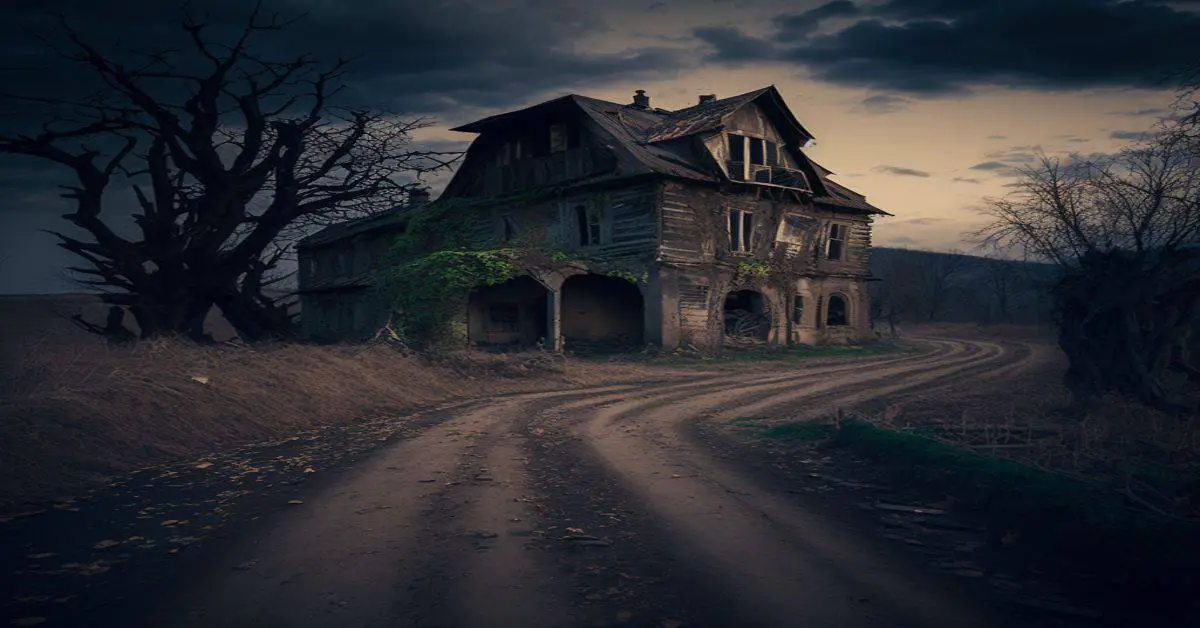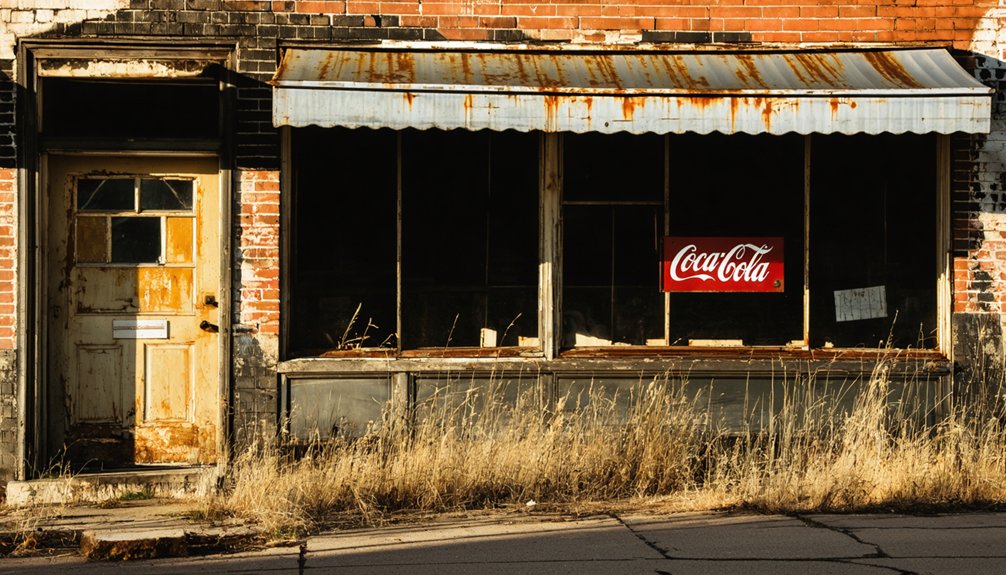You’ll find Enos, Illinois as a representation of 19th-century frontier ambition in Sangamon County. Founded in the mid-1800s around prominent landowners like Pascal P. Enos, the settlement thrived with log buildings, frame houses, and the distinctive Edwards Place mansion. While the town flourished initially with horse-drawn trolleys and civic development, the absence of essential railroad connections led to its decline. The site’s remaining structures and hidden Underground Railroad tunnels hold fascinating historical secrets.
Key Takeaways
- Enos was established in the mid-1800s around prominent landowners like Pascal P. Enos, with settlers paying $1.25 per acre for land.
- The absence of railroad connections ultimately led to Enos’s abandonment, despite early success with horse-drawn trolley transportation.
- Historic structures like Edwards Place and the Enos Building, featuring Underground Railroad tunnels, remain as testaments to the town’s past.
- Population decline permanently altered the town’s future prospects, transforming it from a promising settlement into an Illinois ghost town.
- The Enos Sanatorium, converted from the Nathaniel Hanson Mansion in 1911, played a crucial role in regional tuberculosis treatment.
The Rise and Fall of a Historic Illinois Settlement
While many ghost towns dot the Illinois landscape, Enos presents a unique case in the state’s settlement history.
Like other Illinois communities, its story reflects the broader patterns of economic resilience and social dynamics that shaped the region’s development during the 19th century.
Economic and social forces in Illinois communities during the 1800s reveal the delicate balance between survival and abandonment.
Similar to Cardiff’s tragic history, the town experienced a rapid population decline that altered its future prospects permanently.
The government land office established in 1823 marked the beginning of formal settlement in the area.
You’ll find that Enos faced challenges similar to other settlements of its time, where railroad routes and agricultural changes dramatically influenced a town’s survival.
The community’s fate aligned with the typical progression of Illinois ghost towns, affected by shifting transportation patterns and evolving economic conditions.
In the broader context of Illinois’s abandoned settlements, Enos exemplifies how population movements and changing agricultural practices could transform a once-promising location into a remnant of the past.
Life in Early Enos: a Glimpse Into the Past
As settlers established themselves in Enos during the mid-1800s, the community took shape around prominent landowners like Pascal P. Enos. The local bank flourished under leadership from First National Bank stakeholders.
You’d find families living in log buildings and frame houses, creating strong family connections through marriages and shared civic duties. The settlement’s growth was closely tied to Springfield’s expansion, with the 1866 horse-drawn trolley making travel easier for residents and visitors alike. After serving in Vermont, Enos relocated to Sangamon County in 1823.
- Early settlers paid $1.25 per acre for quarter sections, gradually subdividing the land as more families arrived.
- Family names like Enos and Stookey dominated local affairs, with their children pursuing early education at prestigious institutions like Illinois College.
- The community balanced frontier living with cultural advancement, particularly after the trolley line began bringing tourists to Lincoln’s Tomb.
Notable Buildings and Landmarks
Several notable buildings and landmarks define the historic character of Enos Park, with Edwards Place at 700 North Fourth Street standing as its architectural crown jewel.
Edwards Place anchors Enos Park’s historic landscape as its architectural masterpiece, a testament to the neighborhood’s distinguished past.
As the neighborhood’s only building listed on the National Register of Historic Places, it represents the area’s peak of architectural significance.
You’ll find 18 additional buildings potentially eligible for historic preservation status, including the distinctive Bretz House at 1113 North Fifth Street.
The Enos Building’s basement includes a hidden tunnel that was historically used to shelter slaves seeking freedom through the Underground Railroad.
The 1857 Enos Building features a rare historic tunnel system connected to underground passages beneath Alton.
While demolition since 1977 has claimed several significant structures, the remaining buildings showcase early 20th-century styles like Craftsman and Colonial Revival.
Many retain their original woodwork, porches, and period details that reflect the modest prosperity of this once-thriving working-class neighborhood.
The area’s rich history of paranormal activity has made it one of the most haunted small towns in America.
Medical History: The Tuberculosis Era
During the early 1900s, Enos and surrounding Illinois communities faced a devastating tuberculosis epidemic that transformed local public health practices. You’d find Illinois’ response to TB reflected in the establishment of new health institutions and housing regulations that impacted daily life in towns like Enos.
The state’s aggressive public health campaign included:
- Mandatory case reporting and residence inspections to control TB spread
- Creation of specialized sanatoria facilities for tuberculosis treatment and isolation
- Formation of housing inspection divisions to enforce ventilation and sanitation standards
If you lived in Enos during this era, you’d have witnessed the profound impact of TB on your community. Just as first sheriff John Taylor had established law enforcement standards in Sangamon County decades earlier, local authorities enforced strict quarantine measures while medical professionals monitored cases through the state’s new bacteriologic laboratory, marking a turning point in Illinois’ approach to infectious disease control. The State Board of Health’s investigation of outbreaks became a critical duty that helped contain the spread of tuberculosis and other contagious diseases.
Architectural Evolution Through Time
While Enos began as a modest rural settlement, its architectural character evolved dramatically through waves of development from the mid-19th century onward.
You’ll find early wood-frame houses and carriage houses giving way to more substantial brick structures like the impressive Enos Apartments, built in 1870 as a four-story sanatorium. The arrival of horse-drawn trolleys in 1866 transformed the town’s layout, with architectural styles clustering around transportation nodes.
Similar to the First State Bank of Illinois featuring an ornate limestone facade and portico, the town’s financial institutions reflected architectural grandeur of the period.
As you explore Enos’s streets, you’ll notice the rich variety of architectural styles, from simple vernacular homes to ornate Victorian mansions. The Enos Apartments basement served as a crucial tunnel network for escaped slaves seeking freedom in the North.
Brick institutional buildings stand alongside Folk Victorian and Queen Anne residences, while hidden features like underground tunnels – once part of the Underground Railroad – remind you of the town’s complex history.
Unexplained Phenomena and Local Legends
Beyond the architectural remnants of Enos lie tales of unexplained phenomena that have captivated locals and visitors alike.
You’ll find numerous accounts of paranormal activity throughout the abandoned settlement, from shadowy figures lurking near old foundations to unexplained sounds echoing through the woods after dark. Ghost sightings often coincide with electromagnetic disturbances and sudden temperature drops, particularly during nighttime investigations.
- Reports of mysterious lights dancing among ruins and tree lines
- Electronic equipment malfunctions during attempts to capture supernatural evidence
- Unexplained footprints and object movements in abandoned structures
The area’s connection to Civil War history and Underground Railroad activities has only deepened its supernatural reputation.
Local legends speak of tragic deaths and disappearances that supposedly cursed the town, while some claim to experience an unsettling sensation of being watched while exploring the grounds.
Transportation and Community Development

You’ll find that transportation access played a vital role in determining whether Illinois settlements thrived or became ghost towns during the 19th century.
While the Enos Park neighborhood in Springfield benefited from horse-drawn trolley lines along Fifth Street starting in 1866, the village of Enos lacked similar transit infrastructure that could have sustained its development.
The absence of rail connections and major road networks likely contributed to Enos’s eventual abandonment, following a pattern seen in other failed Illinois settlements that were bypassed by essential transportation routes.
Railroad Impact On Growth
As the Illinois Central Railroad expanded its network across the state, it fundamentally transformed both transportation and community development in Enos and similar towns.
The railroad expansion brought unprecedented opportunities for growth, facilitating community migration and establishing essential connections to larger markets. You’ll find that these rail networks became the lifeblood of local economies, creating jobs and stimulating development.
- The railroad’s presence attracted settlers and businesses, leading to rapid population growth and the establishment of new commercial enterprises.
- Federal land grants enabled the Illinois Central to extend its reach, making previously isolated areas accessible for settlement and trade.
- The construction of rail infrastructure, including stations and maintenance facilities, created permanent employment opportunities and strengthened the local economy.
These developments positioned Enos within a broader network of regional commerce and transportation.
Early Trolley System Development
When local investors proposed an Aurora to Oswego-Yorkville trolley line in 1897, they ignited a wave of community enthusiasm for modern transportation.
You’ll find that these trolley innovations offered faster, cleaner service than traditional horse-drawn transport, while providing reliable alternatives to limited steam train schedules.
The project required significant infrastructure investment, with the trolley company contributing $3,500 toward a new Oswego iron bridge while the township covered remaining costs.
Construction moved swiftly, with tracks reaching Oswego Bridge by June 1900.
These community connections transformed local commerce and social life, linking rural towns to urban opportunities in Chicago.
You could see the impact through enhanced mobility between communities, though operating challenges like fixed fares and rising labor costs would later pressure the system’s long-term viability.
Road Network Evolution
The isolated farmlands north of Springfield’s core marked Enos Park’s early landscape before 1860, characterized by informal paths serving scattered homesteads rather than planned thoroughfares.
As you explore the area’s transportation legacy, you’ll see how the installation of trolley lines in 1866 transformed Fifth Street into a crucial artery, connecting Monroe Street to Oak Ridge Cemetery and reshaping the community’s development.
Key developments in road infrastructure included:
- Gradual expansion through patchwork platting (1833-1965)
- Integration with competing trolley networks that later consolidated
- Strategic positioning of civic institutions along major routes
You can still trace this evolution in today’s street patterns, where historic grid layouts merge with modern automotive expansions, though some early roads remain narrow or discontinuous.
Impact on Regional Healthcare

During the early twentieth century, Enos Sanatorium played a pivotal role in shaping regional healthcare throughout Illinois’ Madison County.
Originally the Nathaniel Hanson Mansion, Dr. W.H. Enos transformed it into a specialized tuberculosis treatment facility in 1911, when the disease was still incurable. You’ll find its impact reflected in how it helped contain infectious outbreaks through patient isolation, preventing wider community spread.
The facility’s evolution mirrors the broader healthcare evolution of the era, from its expansion with a fourth floor and nurses’ home to its later conversion into apartments.
As one of the few regional centers for tuberculosis care, Enos established essential medical infrastructure that would influence local healthcare development for generations, demonstrating how specialized care facilities could serve critical public health needs.
Modern-Day Remnants and Preservation Efforts
You’ll find the most prominent remnant of Enos in the former sanatorium building, now preserved as the Enos Apartments, which maintains its historic 1857 architecture including the fourth floor addition and underground railroad tunnels.
Local preservation groups actively document and maintain the site’s historical features, from the basement catacombs to surrounding neighborhood structures that date back to early 20th century development.
The community’s dedication to protecting this heritage extends beyond the main building to include mapped underground passages, historic markers, and educational programs that connect visitors to both the medical and Underground Railroad history of the area.
Historical Structures Still Standing
Several historic structures from Enos’s heyday remain standing today, offering visitors tangible connections to the town’s fascinating past.
You’ll find the most notable example in the Enos Apartments, which maintains its architectural integrity despite its evolution from an Underground Railroad station to a modern residential building.
The Nathaniel Hanson Mansion, perched on a Mississippi River bluff, stands as a monument to the town’s historical significance in the fight for freedom.
- The mansion’s distinctive cupola once served as a beacon for escaping slaves
- A network of tunnels, similar to Roman catacombs, runs 15 feet beneath 3rd Street
- The 1911 conversion to a tuberculosis sanatorium added a fourth floor and nurses’ quarters
These preserved structures continue to tell the story of Enos’s role in American history.
Community Preservation Projects Today
Modern preservation efforts in Enos highlight a determined community’s commitment to protecting its historical legacy. Through the Enos Park Neighborhood Improvement Association, you’ll find active community engagement in preservation initiatives that focus on saving historic homes and architectural treasures.
The area’s preservation strategy includes matching grants for exterior rehabilitation projects and targeted efforts to eliminate blighted properties.
You’ll see this work complemented by community-driven initiatives that combine historic preservation with mixed-use development, creating a sustainable path forward for the district. TIF funding supports these preservation goals, while regular community meetings guarantee residents have a voice in protecting their neighborhood’s character.
Educational programs help raise awareness about the importance of maintaining Enos’s architectural heritage for future generations.
Archaeological Site Documentation Progress
Extensive archaeological documentation of Enos reveals a rich tapestry of historical significance, particularly centered around the 1857 Enos Sanitarium and its underground railroad connections.
You’ll find preservation strategies focused on capturing both above-ground structures and the limestone tunnels that once sheltered freedom seekers.
Archaeological methods employed at the site include:
- Thorough photographic documentation of original architectural features
- Detailed mapping of underground tunnel networks and connection points
- Integration of archival research with physical evidence to verify escape routes
The site’s documentation efforts align with broader preservation work across Southern Illinois, where over eighty archaeological sites demonstrate the region’s rich cultural heritage.
Modern-day archaeological investigations continue to uncover new details about Enos’s role in the Underground Railroad while battling preservation challenges from ongoing development.
Frequently Asked Questions
What Happened to Dr. Enos After the Sanatorium Closed?
You won’t find definitive records of Dr. Enos’ legacy or later ventures after the sanitarium’s closure. Historical documents don’t reveal what became of him, leaving his post-sanitarium life a mystery.
Were Any Famous Patients Treated at Enos Sanatorium?
Like the empty halls that echo through time, you won’t find any famous patients in the sanatorium’s history. No records document any notable individuals treated at Enos during its operation.
How Many Deaths Were Recorded at the Sanatorium During Its Operation?
You can’t access exact mortality rates since patient records and death counts are legally restricted by Illinois law. The actual number of deaths at the sanatorium remains confidential state information.
Did Any Nurses Report Paranormal Experiences While Working at the Facility?
Like whispers lost in time, you won’t find documented nurse testimonies about ghost sightings during the facility’s operation. Historical records don’t mention any paranormal experiences from the nursing staff.
What Original Medical Equipment Still Remains in the Building Today?
You’ll find examination beds, oxygen tents, x-ray machinery, essential sign recorders, and “Sani-Glas” labeled equipment – all historical artifacts reflecting early 20th century medical practices in the building’s preserved spaces.
References
- https://www.distilledhistory.com/hauntedalton/
- https://www.riversandroutes.com/blog/why-alton-is-americas-most-haunted-small-town/
- https://epnia.com/history-and-development-of-the-enos-park-area/
- https://en.wikipedia.org/wiki/List_of_ghost_towns_in_Illinois
- https://blueridgemuse.com/node/13117
- https://www.youtube.com/watch?v=93k0qtvzkn4
- https://www.heraldtimesonline.com/story/lifestyle/home-garden/2021/01/15/some-illinois-ghost-towns/43846097/
- https://www.youtube.com/watch?v=gM3ZIgtFzBk
- https://www.freakyfoottours.com/us/illinois/
- https://drloihjournal.blogspot.com/p/lost-towns-of-illinois-series.html



